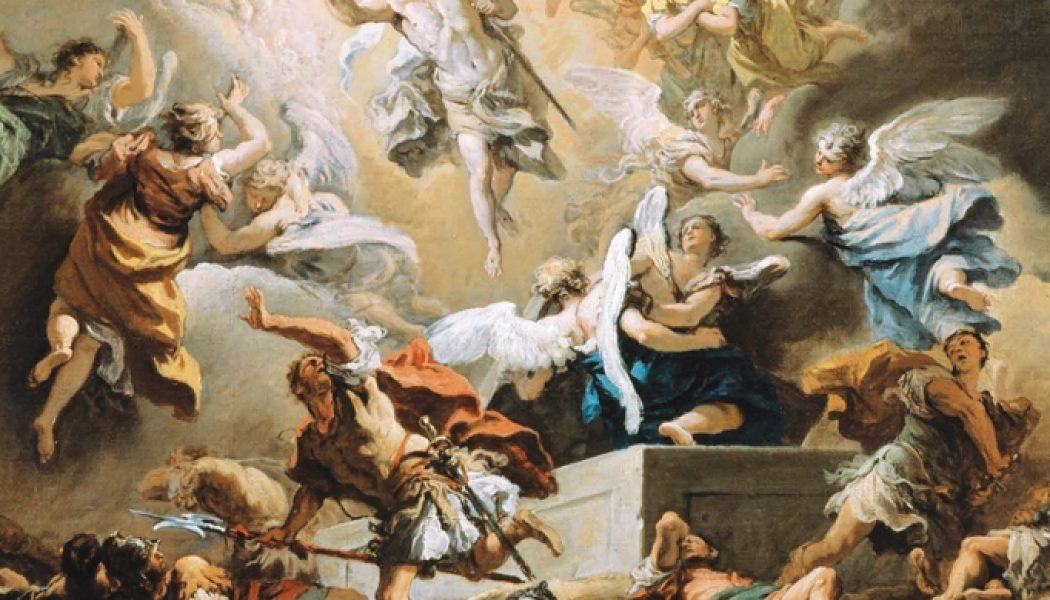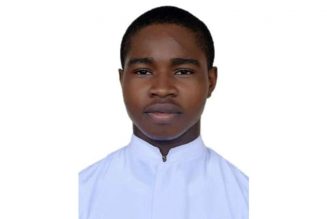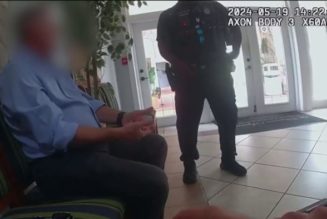
Excerpt from Hope to Die: The Christian Meaning of Death and the Resurrection of the Body
Editor’s Note: This excerpt is from the Postscript of the forthcoming book Hope to Die, which Scott Hahn wrote with Emily Stimpson Chapman. Hahn wrote this section specifically in response to the coronavirus crisis. It is reprinted with permission.
Easter 2020 was always the scheduled release date for this book. Emily and I worked on it during the summer of 2019, finished our edits over Christmas, and on February 28, 2020, a week before the book was scheduled to go to press, filmed an episode about it for the television show Franciscan Presents. Then, days later, the coronavirus known as COVID-19 started spreading across the United States. And I stopped the presses. I’ve never done that with a book before. But I didn’t want to put this book into the hands of people still reeling from both the rapid spread of the virus and the societal changes that have followed without adding a few final thoughts. Because death, for many of us, just became a whole lot less abstract and life far more uncertain.
In so many ways, the situation in which our world suddenly finds itself is unprecedented. But, in others ways, it feels very familiar.
I’m thinking, of course, of September 11, 2001. I still remember the shock and sorrow I felt watching the Twin Towers fall. I also remember the uncertainty of the days that followed. We didn’t know then if and when the attacks would end. We didn’t know what more the terrorists had in store for our country. All we knew was that in the space of a few hours, thousands of our fellow Americans died horrible deaths. And we were scared.
For many of us, 9/11 was a wake-up call — a reminder that our comfortable settled lives could be upended in a moment, that death can always be just one heartbeat away, and that nothing in this world is ever certain, least of all tomorrow.
Not long after the Towers fell, Kimberly and I gathered the children to pray. Like us, they were struggling to make sense of what had happened and Hannah, who had just turned 13, had a question for me.
“Dad,” she said, “I have to know — are we all going to die?”
“Yes,” I responded. “100 percent. Definitely.”
All the kids, looked at me, startled. I paused. Then, I continued. “Everyone’s going to die, Hannah. But I don’t think it will be today.”
I added, “But the important thing, the real question, is not are we going to die, but are we ready to die?”
Later, after we finished our prayers, I turned the conversation back to Hannah’s question. I explained that while the mortality rate for each of us is 100 percent, the immortality rate for each of us is also 100 percent. Death is not the end. Not for anyone. Every person who has ever lived is still alive in one state or another — a state of grace or state of disgrace.
I then referenced St. John Henry Newman’s sermon on “The Individuality of the Soul.” In it, he reminds us:
All those millions upon millions of human beings who ever trod the earth and saw the sun successively are at this very moment in existence all together. This, I think, you will grant we do not duly realize. All those Canaanites, whom the children of Israel slew, every one of them is somewhere in the universe, now at this moment, where God has assigned him a place.
I’m not sure how much of an impression the Newman sermon made on the kids at the time, but it has stayed with me, this vision of the masses of humanity — from Adam and Eve and the men and women who died on 9/11 to those dying, even as I write, from a horrible virus that literally takes your breath away. As I watch the news unfold, I can’t help but think of them all, still living, still waiting, still anticipating, whether in fear or hope, the Last Day.
From Curse to Blessing
In death, the divide between hope and fear is unbridgeable. Each of the waiting dead knows what will happen to them at the time of the Final Judgment. They know if their body will be resurrected to death or to life. Those who hope, hope with certainty. Those who fear, fear with equal certainty. They all know what they freely chose in life — heaven or hell —and they know the time for making another choice has passed. Christ the Judge has pronounced their fate, and that fate is sealed.
But here and now, the chasm between hope and fear can be crossed. We don’t have to dread the end of this earthly life. We don’t have to live in terror about what comes after we close our eyes for the last time. No matter how far we’ve run from God, no matter how often we’ve chosen against him and his ways, we still have time to make another choice. Like the Prodigal Son, we can run back to the Father’s house and know that he will welcome us with open arms, transforming our fear of death into hope for life.
The fear so many of us feel in the face of death is, of course, natural. We weren’t made for death. We were made for life.
Jesus came to release us from our fear of death, though. The loving obedience he offered on the cross atoned for our sins and opened the gates to Heaven for all who followed him. But it also changed the very meaning of death for those united to him. It “transformed the curse of death into a blessing,” making death the door that leads to everlasting life with God (CCC 1009).
Quoting Saint Paul, the Catechism explains:
Because of Christ, Christian death has a positive meaning: “For to me to live is Christ, and to die is gain.” . . . What is essentially new about Christian death is this: through Baptism, the Christian has already ‘died with Christ’ sacramentally, in order to live a new life; and if we die in Christ’s grace, physical death completes this “dying with Christ” and so completes our incorporation into him in his redeeming act. (1010)
That is to say, for those who die in Christ’s grace, death isn’t a solitary act; it’s “a participation in the death of the Lord,” and when we die with the Lord, we also rise with the Lord; we participate in his resurrection (CCC 1006).
This participation changes everything. The Church’s liturgy reminds us of this. “Lord, for your faithful people life is changed, not ended,” we hear the priest say at funeral Masses. “When the body of our earthly dwelling lies in death we gain an everlasting dwelling place in heaven.”
When we know death is not the end, when we know that death is just the beginning of everlasting joy, everlasting life, and everlasting communion with the One we love, hope drives out fear. It makes us long for death. It makes us long to be with Christ in a world where there is no suffering, no pain, no loss. This is why St. Francis could pray:
Praised are you, my Lord, for our sister bodily Death, from whom no living man can escape.
Woe on those who will die in mortal sin!
Blessed are they who will be found in your most holy will,
for the second death will not harm them. (CCC 1014)
Knowing death is not the end also makes us long for something else. It makes us long to share our hope with others.
* * * * * * *
The first Christians — our fathers and mothers in the faith — didn’t fear death; they anticipated it. Many of them ran toward it, wanting nothing more than to begin what C.S. Lewis (The Last Battle) described as “Chapter One of the Great Story, which no one on Earth has read: which goes on forever: in which every chapter is better than the one before.”
People often refer to the Gospel or even salvation history as “the greatest story ever told.” But it’s not really. It’s just the introduction. Or a prelude. What comes after this life, when the blessed enter into the Beatific Vision and see in the Father’s eyes the story of their life, of everyone’s lives, of all the world, that will be the greatest story ever told, the one to which every other story belongs, the story that makes sense of all the stories, the story we’ve been waiting our whole lives to hear.
Right now, as Christians, we’re called to imitate those first Christians. We may or may not be called to run toward death in the arena or the hospital ward. But we are most certainly called to set aside our fear of death and live in hope. We are called to hope that we will see our lost loved ones again and to hope that with them, one day, we will rest in the arms of our Father.
We’re also called to hope in the God who took the single greatest evil ever perpetrated — the crucifixion of our Lord — and brought out of it the single greatest good the world has ever known: the redemption of humanity. If God can bring goodness and glory and beauty and life out that kind of evil, he most certainly can bring goodness and glory and beauty and life out of the evil we presently face.
Hope is what will sustain us in the days yet to come. It also will make it possible for us to experience joy in this day, no matter what sorrows presently afflict us.
Again, death is not the end. We were made for life. We were made for joy. And in Christ, that life and joy will be ours. In Christ, that life and joy are already ours. Death brings the fulfillment of that life and joy, but we can live in it now. Even in the midst of grief. Even in the midst of war. Even in the midst of plagues and poverty and confusion. If we are in Christ, we have nothing to fear from the terrors of the world. They cannot kill the life inside us. They cannot deprive us of the joy that is ours. They cannot rob us of the hope that fills us — the hope of eternal life.
“O death, where is thy sting?” —1 Corinthians 15:55
Scott Hahn
March 19, 2020
Solemnity of St. Joseph, Patron of a Holy Death







